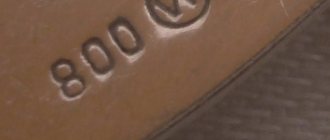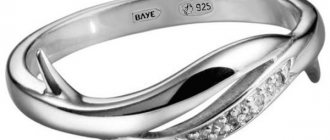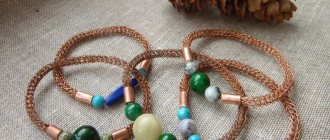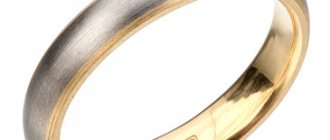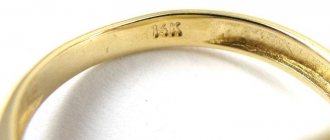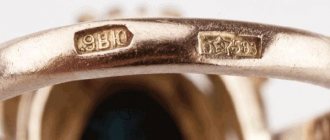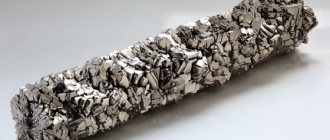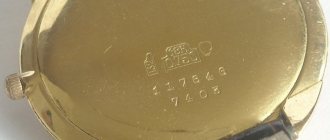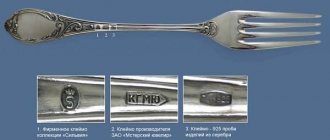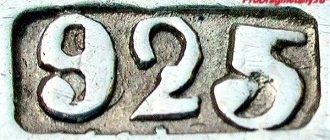Each mark on silver belongs to one or another assay system. For example, the hallmark of 84 hallmarks refers to the ancient hallmark system, which is called “spool”. This is how silverware was branded even before the revolution, although this method was actively used in the USSR. The 84 silver hallmark appeared at the end of the 18th century, but other markings also exist. Now craftsmen work according to the metric system and test products according to a special table. The set will highlight the hallmarking of precious metals, their principles and types of alloys that are subject to assaying.
What does a hallmark mean on silver items?
You will not find such marks on silver bars, which do not have impurities. The fact is that pure precious metal is very soft and is not intended for creating jewelry or decorations. Craftsmen deliberately began to add other impurities to these metals in order to make the raw material harder and more convenient for processing. In addition, objects made of pure metal have the ability to lose shape.
These may be various components that will be indicated in the product certificate. The most popular additives were considered to be zinc, aluminum, copper and cadmium. Based on the amount of impurities in ounces, the fineness of the silver or other precious metal can be determined. The hallmarking system prescribes the percentage of pure silver in the alloy.
What does a hallmark mean on silver items?
On a note! The number of the hallmark on silver objects or jewelry means how many shares of silver are present in the product, and how many shares of additional impurity.
Branding of coated products
Silver in this case can be either the base metal or act as a coating. In the first case, the product is most often plated with gold. Then two samples are placed: the first - of the main alloy and the second - of the alloy with which the decoration is coated.
Cutlery is most often plated with silver. This was especially widespread in the USSR. Then, in parallel with the metal sample, the base alloy was marked. At this time the following designations were adopted:
- MN - cupronickel. Sometimes the designation MELCH was also found.
- MNC - German silver.
- AL - aluminum.
- STAINLESS – stainless steel.
In ancient antique objects, this also happened: only a coating test was given, without indicating the main alloy. This is quite dangerous, since a silver-plated product can be mistaken for being made of pure metal.
The following silver alloys are subject to hallmarking all over the world:
- 800 sample. Composition: 80% silver, the rest copper. It oxidizes quickly and has a pronounced yellowish tint. 830 sample has characteristics similar to the previous one.
- Sample 875. Contains 87.5% silver. Very often used for making tableware and decorations.
- 925 sample is the most common. It has an optimal price-quality ratio. It has high anti-corrosion properties and does not have a yellow tint. Very easy to change shape. Mainly used for jewelry.
- 960 standard is used by artists when working with enamel, as well as for jewelry, especially abroad.
History of the Assay System
Not only numbers are used by the assay system, but also letters. If previously the sample carried more detailed information: the value of the item, the name of the jewelry maker and even the date of manufacture, now branding occurs strictly according to a system table. In Rus' this art has been studied for a long time. Only the master himself or his chief assistant could set samples. At the beginning of the 19th century, the Russian emperor even issued a decree that special chambers should be equipped for hallmarking silver and other metals.
The marking system has evolved, and along with it, the print itself will periodically change. There was one for each category of precious metals. The first print was in the form of a woman’s head in a kokoshnik, but each individual district in the Russian Empire had its own mark, on which letters were printed. They were the initials of the head of the district. Then it was decided to put an abbreviation according to the regions. At that time in Russia there were many German craftsmen who made their products from silverware with personalized names.
A unified testing system appeared under Peter the Great, in 1899. It was he who obliged the craftsmen to indicate the sample on the precious metal so that they could roughly determine the value of the item. An interesting fact is that on the first print the woman’s profile was turned to the left, and the mark itself was a primitive design. When high-quality fakes of the sample began to appear, it was decided to complicate the mark and in the final version, people saw the woman’s face, already turned to the right. In addition to this change, the craftsmen added additional touches to the image so that fraudsters could not fake it without special skills and equipment.
On a note! After approval of the new brand, each district additionally put down the letter abbreviation of its district.
Silver samples
In the international metric system, the most common silver standards are:
- 800 silver;
- 830 silver;
- 875 silver;
- Sterling Silver;
- 960 silver;
- 999 silver;
You can learn about what other silver samples there are: concept, types, authenticity here.
Types of hallmarks on silver
Over the entire era of the stamp, there are several dozen impressions. They appeared at one time or another and were not all included in the official marking table. Some positions have survived to this day, but the main part has sunk into history. Now you can find sample No. 875, and the alloy in composition and characteristics is identical to that which was branded under number 84. This is due to the fact that sample 84 belongs to the spool system, and 875 to the metric system, which was created in 1927. Alloy 925 is also popular in the modern world.
The stamp itself can be made in the form of an oval, the sides of which are slightly cut off. There should always be a letter at the bottom of the stamp. Using it you can find out in which region or locality the product was tested. Since ancient times, branding has been handled by a separate department, which simultaneously evaluates the item based on chemical analysis of individual components. This procedure can be done manually, during jewelry making, or using a special device. Brands are written with the following symbols: “A”, “B”, “C”, “D”, “D”, “E”, “F”, “Z”, where:
- A and B are a round print with a woman’s head, and the sample is located behind the circle, near the image.
- C and D – a round print with a five-pointed star, with a hammer and sickle inside, and the sample is located behind the circle, near the image. This mark dates back to the USSR era.
- “D”, “E”, “F”, “Z” - do not have independent meaning. It is applied as an additional stamp. Without a standard stamp, such a marking cannot confirm that the item is created from silver metal.
In modern jewelry, only the meanings of “D” and “E” are used. The first letter is depicted on precious things, enclosed in a rectangle, the ends of which are slightly rounded. The letter designation "E" is used extremely rarely. It is placed on products that do not correspond to the declared sample. Again, this is done in the approbation department, because each metal unit must undergo appropriate testing.
In modern jewelry, only the values of “D” and “E” are used.
It should be noted that the letter “B” is placed on some items after production. It may mean that the products will be exported abroad or, on the contrary, have arrived in Russia. Without this sign, the goods simply will not be allowed through the customs zone. In this print, instead of a woman wearing a kokoshnik, a sea vessel is depicted. If a person comes across jewelry with such a stamp, it means that it was either made abroad or came from there.
Many jewelry factories create their own stamps, but the presence of name marks does not replace the main stamp, which confirms the composition of the alloy by a competent department. Only those companies that do not claim to confirm individual components of the product can make do with a personal imprint. This is what workshops do that produce expensive jewelry and give it a presentable appearance with silver plating. There are also so-called “holiday” or “temporary” stamps:
- In 1967, an astronaut was present in the oval for 60 days. This seal was made for the 50th anniversary of the October Revolution. Many antique lovers keep silver coins with this sign.
- Until 1994, jewelry workshops that created church paraphernalia from silver could only brand it with the letter “D.” Now the church again wants to achieve its own distinctive sign, but so far their request is not being considered by the state.
- Also, until 1997, all medals that were issued to heroes of the Soviet Union and people for their contribution to the development of the state were subject to branding.
On a note! In the Soviet Union, it took a long time to displace German stamps. Devices with this imprint can still be found to this day, but most of them are in a museum in Moscow.
Chronology of sample use in our country
- Since 1899, on the basis of the newly introduced statute, an assay mark was established in the form of a woman’s head in a kokoshnik, only still turned to the left, and an assay in the spool system.
- In 1908, the head was already turned to the right, and a letter was added to the mark indicating the assay district to which the product belonged; the sample was still spool-like.
- In 1927, a new brand was introduced in the Soviet Union: it depicted the head of a worker with a hammer. And also a new sample system was introduced - the same one that is used now, metric. The assay district was still designated by a letter of the Greek alphabet.
- In 1958, prints with the image of a star with a hammer and sickle were introduced. The letter of the Greek alphabet was replaced with a letter of the Russian alphabet.
- The prints acquired their modern appearance in 1994, but were used alongside the old ones until April 2002.
And although silver in the form of jewelry is rarely used as an investment, it is still worth paying attention to the hallmark when purchasing it. Especially if jewelry and cutlery are bought secondhand, which is not recommended. It is possible to fake a sample, but it is difficult and dangerous. Therefore, it can be considered a sufficient guarantee of the quality of the metal.
Principles of branding
The mark can be located inside or outside the product. The very first and most popular method is mechanical. Every jewelry maker should have this art. At first, an ordinary hammer was used for this, and then a special mechanism was made that carried out the process automatically. There were also special anvils, without which it was almost impossible to accurately apply a jewelry stamp. The machines had already been introduced when mass branding was required.
The electric spark method is carried out with the participation of electrodes
The electric spark method is carried out with the participation of electrodes. For this purpose, a special installation was made, with the help of which the print is burned out with a spark. If the brand has jumpers at the top between the outline and the badge, it means that this item was branded using the electric spark method. This method is more effective, but not all jewelry workshops and factories use it, because such an installation costs a lot of money.
For very expensive jewelry, a special laser can be used, which applies the mark very carefully. This method is not as relevant in mass production because the laser mark disappears over time. If a person has purchased such a product, then he needs to treat it more carefully, because after a while the mark will simply disappear and it will no longer be possible to confirm that the jewelry belongs to the precious right.
IMPORTANT! It is not so difficult to fake a sample, but the master will immediately understand that it is not real. In Soviet times, it was precisely because of the work of scammers that the prints changed several times. Most often, counterfeit items were found in silver dishes.
How to distinguish the authenticity of a stamp?
Knowing what the quality mark of the alloy looks like on Soviet or Tsarist gold, it is easy to distinguish the authenticity of the mark on the jewelry that was inherited. They often fall for the tricks of scammers when purchasing jewelry second-hand, when they offer a fake with gold plating under the guise of high-grade metal.
In order not to make a mistake when choosing a product in a jewelry store, you should carefully examine the print with a magnifying glass. A counterfeit stamp, and therefore the low quality of the precious metal, is evidenced by blurred images, uneven inscriptions, improper appearance and incorrect placement of the print.
Silver alloys subject to hallmarking
They put a mark on many products made of precious metals. The standard mark marks all jewelry that weighs more than three grams. The following items are subject to mandatory branding:
- Having historical value.
- Of archaeological significance.
- Ingots of imported and domestic production.
- Nuggets.
- Silver leaf.
Despite the fact that most of the historical treasures are in the museum, archaeologists find new parts made of precious metals every day. Before transferring them to museum institutions for storage, they are checked and branded with a special sign. Even if the product contains a mixture of alloys, it must have a sample on it. For example: a ring made of silver and gold: two stamps. Any items made of precious metals that are created for scientific or industrial needs are not branded. Such things are subject to special consideration. Such records can be found in journals of laboratories, medical and other professional institutions.
If a person sees a silver item, but cannot detect a hallmark on it, then most likely this item was made by a private craftsman or does not belong to precious alloys. When products are sealed, each item is indicated in a special registration book. The authenticity of the sample can be confirmed or refuted by any jeweler with a magnifying glass at hand.
Famous world manufacturers of silverware
Antique silver is the most valued item: its value increases every year. Rare silver from famous manufacturers of the past has the highest cultural and historical value and is sold mainly in antique stores or at auctions.
Nevertheless, even now you can buy luxurious silverware from both Russian (Veliky Ustyug, the famous Argenta, Kostroma Jewelry Factory) and foreign (British Royal Buckingham, German Robbe & Berking and Koch & Bergfeld) manufacturers. Yes, it’s not cheap, but it’s a smart investment: luxury silverware will only become more expensive from year to year!
18.08.21
Names and letter designations of jewelry (code)
Bracelets B , BR ; Brooches BR , BS , B ; Vases B ; VL plugs ; Decanters G ; Clamps 3 ; Cufflinks ZP ; ZN icons ; KL necklace ; Rings K ; KB Cups ; KN pendants ; Spoons L ; Spatulas for cakes LP ; Medallions M ; Thimbles N ; Leaf cutter knives NL ; Knives NZh ; Necklaces O ; Ashtrays P , PP ; Cup holders PD ; Egg coasters PYA ; Cigarette cases PR ; Powder compacts PDN ; Sockets P ; RM glasses ; Sugar bowls CX ; Earrings C ; Salt shakers SL ; Stacks ST ; Chains C ; Cups H ; Teapots CHN ; Sugar tongs Shch .
Structure of the hallmark
The structure of the hallmark, established since 1994 in Russia for products made of precious metals.
Source
Which spoons are valued?
First of all, sets are valued, not isolated copies. Of course, a spoon with a master's name, decorated with a monogram, also has a high cost. But not only millionaires can afford to buy them. The cost of devices is in the thousands, not millions of dollars.
In 1912, at a Christie's auction, a pair of Faberge spoons went for $8,000. The spoon, made by Fedor Ruckert, sold for $12,500.
Silverware from German jewelers is prized throughout the world. The Robbe&Berking company supplies instruments to the palaces of oil sheikhs and to the court of the Queen of Great Britain. The companies Robert Freund, Franz Schnell Halle, Herbert Zeitner became famous.
English tableware from William Suckling, Ridley&Hayes and many other craftsmen is prized. Jewelers from Denmark also became famous for their silver products.
Among the masters from Russia, the firms of the Grachev brothers, Sazikov, Ovchinnikov, Khlebnikov and, of course, Faberge are famous.
Many of them were suppliers to the imperial court. This was honorable and prestigious; usually the products of these companies were branded with a special sign.
How much do the devices of these masters cost in Europe? The prices cannot be called exorbitant. For example, a gilded spoon, the handle of which is decorated with an image of the Virgin and Child, by the famous master A. Michelsen (Denmark) is valued at $230. It was made in 1916. Prices for this master's devices range from $50 to $600 per unit.
Antique silver spoons of the 19th-18th centuries, made by famous masters, may cost a little more. For example, a set of silverware (six forks and spoons) - manufactured in 1855 - by jeweler Hippolyte Thomas in one of the online antique stores is offered for one and a half thousand dollars. The devices are decorated with the owner’s monogram and look great; their weight is more than a kilogram.
